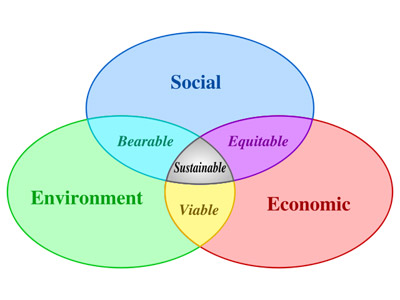Suburbia: What a Concept
By ALLISON ARIEFF
There is no more iconic suburb than Levittown, the postwar planned community built by the developer William Levitt in the late 1940s, so it is understandable that in launching Open House, a collaborative project to imagine a “future suburbia,” the Dutch design collective Droog in collaboration with Diller Scofidio + Renfro architects would make it the focus of their inquiry.
"Future Suburbia"--now, that looks promising, especially if it can solve the issues facing a car-centered way of living during a time when being car-centered is likely to be more of a liability than an asset. It would be nice if the designers came up with something that actually solved some of the real problems with suburban living during a time of resource shortage and economic contraction that was more uplifting than Kunstler's dismal vision of them being "the slums of the future" with "two or more families living in a McMansion" and "crops growing where the front lawn used to be." Unfortunately, they didn't.
But in approaching a real place as a perfect blank canvas on which to execute distinctly urban interventions, the Open House project conveniently excused itself from substantively engaging with the real issues facing suburbia’s future. Which is a pity. Because it would have been interesting to see what they’d come up with if they had.
What a wasted opportunity!
[T]he suburban existence is as exotic to them as say, Dubai, the site of Droog Lab’s first project where, says co-founder Renny Ramakers, they’d made a deliberate decision not to explore it as “a spending society — people felt we weren’t being critical enough; they couldn’t understand why. In this project I don’t want to be critical, I want to look for inspiration because in every part of the world, people are creating their own society, their own community.”
But that’s not really valid. Can we discuss the future of suburbia (or the future of anything, really) without being critical? Without talking about developing accessible transit or increasing walkability (and community) through mixed-use development, for example? This alas, is not uncommon. Addressing suburban ills requires massive change to systems, to finance, to transportation and infrastructure, and perhaps most challenging, to a culture deeply wedded to suburbia as emblematic of the American Dream.
Ms. Arieff shows that she has a good eye for the real problems of suburbia. In fact, her list of problems, including her observation that the U.S. has become wedded to suburbia as the American Dream, makes her seem as if she's watched "The End of Suburbia," in which exactly the issues she mentions plus suburbia as the American Dream, are major topics, along with peak oil. Too bad the designers seem not to have watched the movie.
So, what did the designers come up with? A scheme for suburanites to "discover their inner service provider." No, really. They wanted the suburbanites to recreate the Manhattan service economy of people being paid to walk dogs, deliver food, and coach each other on their love lives.
I have two things to say to them. First, you people have no idea. Second, go peddle your ideas in Los Angeles. There are all kinds of neighborhoods on the West Side and the edges of the San Fernando Valley where people might listen to ways to be more like sophisticated New Yorkers. Find the fans of "Sex in the City" and start with them.
Even if one has a more mundane set of concerns that would still apply in a business as usual environment, the designers still failed to address the present-day problems.
I asked Ramakers whether Droog’s suburban intervention might help address as well some of the more immediate needs associated with suburbia, like the number of people trying to hold on to their homes in the midst of the foreclosure crisis, or ways of retrofitting large homes into multi-family housing, or integrating transit to reduce traffic and resource usage?
“I don’t think so,” she told me. “Because the emphasis was really on the inner service provider.
As I wrote, what a waste of an opportunity.
When the [Droog Lab] team did the research on service economy [in New York City] they found out from lots of people who created jobs for themselves. They did so partly to earn money, partly to gain self-confidence. We want to encourage people to do something they’re good at.”
I had a little encounter with people running business that cater to "what they're good at" instead of necessities a few days ago, when my wife and I drove down Woodward.* We passed a "Self-Improvement Station" that sold "psychological and educational books." During flush times when people are concerned with first-world problems, that business model would work fine. It might even work during the early stages of a crisis. But if a crisis deepens, then I think there might be better ways to improve oneself than reading books about psychological self-help, like learning how to be better home gardener.
Speaking of which, there was one tangible project that Ms. Arieff thought was on the right track.
A glimmer of hope was found at House #4, Bright Dawn Farm by Freecell (Lauren Crahan & John Hartmann). Here, the designers had clearly collaborated more closely with homeowner Dawn Occhiogrosso, an avid gardener, and had transformed her backyard into a suburban farm. I’ve been yammering on about the positive benefits of growing one’s own food for years now so of course this project was my favorite. Freecell’s horizontal greenhouse was a potent symbol of spring, of possibility, displaying even in the midst of the mizzle rows of beautiful basil, cilantro, tomato starts and other vegetables and herbs (all for sale on your way out: 2 bunches for $5).
The neighborhood benefit of #4 seemed immediately apparent: the homeowner could cultivate her crops and host a weekly summer market, encouraging community involvement and healthy eating, and getting more folks out of their cars and walking through their own community.
Hey, I think that's a good idea, too.
But when I asked Occhiogrosso whether she planned to go ahead and put the plants in the ground, she said no, she didn’t have the time or the inclination.
Looks like someone stumbled over an answer, then picked themselves up and kept on going.
Ms. Arieff thought one other project held promise, but it wasn't any one of the conceptual makeovers of the participants houses.
What what most tangible in Open House was the work that remained most invisible. The design team of EFGH (Hayley Eber and Frank Gesualdi) with Irina Chemyakova explored the potential benefits that changes to code, zoning and other regulatory modifications might have on the existing suburb. The things they proposed, much in keeping with the work of others spearheading the movement to rethink suburbia like Ellen Dunham-Jones, June Williamson and Galina Tachieva, included increasing density, retrofitting existing buildings for new uses, and experimenting with public/private space.
These changes, along with residents’ inclination to improve their own communities, could lead to better models for future development.
If you're interested in sustainability on the local and personal levels, your biggest obstacles will be homeowners associations, zoning boards, and city councils. Those people will be wedded to business as usual long after it becomes apparent to early adopters that BAU just isn't working any more. Watch those local governing entities hang onto the past like adherents of a cargo cult. If I want to urge any political action (and I actually have a long list of political actions; I just haven't broadcast most of them on this blog), it's to convert a critical mass of people to the necessity for sustainable action and then organize to run for positions on these roadblocks to sustainability. I like the idea of a democratic takeover of local government. How's that for a good "Maybe?"





